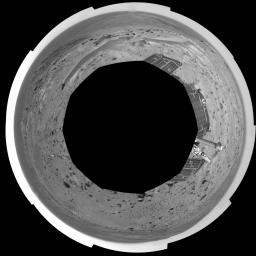In this time of year when Mars is most likely to be covered by global dust storms, NASA's Spirit rover has been experiencing relative calm. In fact, the martian winds have been quite beneficial, clearing dust from the rover's solar panels and increasing the solar energy available for driving to new places and conducting scientific experiments.
Another thing the martian wind has done is send hundreds of dust devils spinning across the surface of the planet. From Spirit's high perch approximately 90 meters (295 feet) above the surrounding plains, as shown in this image taken from the summit of "Husband Hill," three dust devils are clearly visible in the plains of Gusev Crater. Planetary Scientist Ron Greeley of Arizona State University, Tempe, describes the whirling vortices of wind and dust as "vacuum cleaners" that were first seen in images from the Viking Orbiter in 1985, though their existence was predicted as early as 1964.
The most prominent dust devil in this image, visible on the left side of the 360-degree panorama, is one of the closest seen by Spirit. It is about 2 kilometers (1.2 miles) away from the rover, about 90 meters (295 feet) in diameter at its widest point, and 275 meters (902 feet) tall. Its flux is about 1 kilogram per second, meaning it is picking up about 2 pounds of sediment each second and moving it around.
The smaller dust devil just to the right of the largest one is 2.5 to 3 kilometers (1.6 to 1.9 miles) away and is churning up about 0.5 kilograms (1 pound) per second. Both are north of the rover's position and are moving in an east-southeast direction. On the right side of the mosaic shown here is a third dust devil.
Greeley has calculated that if the number and frequency of dust devils Spirit has encountered are similarly spaced throughout Gusev Crater, the crater probably experiences about 90,000 dust devils per martian day, or sol. Collectively, the whirlwinds lift and redeposit an estimated 4.5 million kilograms (9.9 million U.S. pounds) of sediment per sol.
Spirit took this mosaic of images with its navigation camera on sol 581 (Aug. 22). Straight ahead, just east of the rover, is the summit of "Husband Hill." The 360-degree field of view is presented in a polar projection with geometrical seam correction.

 Planetary Data System
Planetary Data System












